June 1st caterpillar update
June 1, 2017
Many of your gypsy moth questions can be answered on the excellent DEM gypsy moth website:
http://dem.ri.gov/programs/forestry/gypsy-moths/
I know this wet weather has been depressing and stopping everyone from working outside, but I’m feeling grateful. Wet weather is making gypsy moth caterpillars susceptible to the fungal disease, Entomophaga maimaiga. Spores of this fungus blow around and land on gypsy moth caterpillars. Gypsy moth caterpillars must be wet for the spores to germinate and then infect gypsy moths. Once a caterpillar is infected it takes about a week for the caterpillar to die and then produce spores to spread to other gypsy moths. I saw my first dead gypsy moth caterpillar on May 22nd and now (June 1st) I think about 1% of gypsy moth caterpillars have died. I haven’t done an actual count – 1% dead is a rough estimate. It can be difficult to distinguish between a dead caterpillar and an empty, shed caterpillar skin. See pictures below.
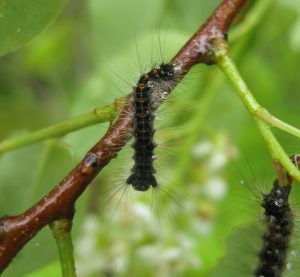
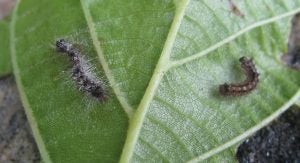
Gypsy moth caterpillars dead from fungal disease. Caterpillar on far right is alive.
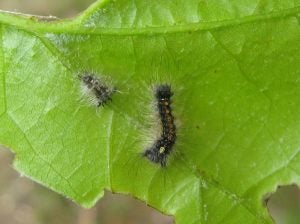
Live gypsy moth with its shed skin to the left.
Entomophaga maimaiga usually kills most of its victims when gypsy moth caterpillars are full-sized, so after gypsy moths have done most of their feeding damage. With this extensive wet weather we have been experiencing, we hope many gypsy moth caterpillars will die before reaching full size. We will find out over the next several weeks. Gypsy moth caterpillars are usually full-sized and finished feeding in late June.
Most gypsy moth caterpillars I’m seeing now are about one inch long, though many have molted to a larger size. Larger caterpillars are more difficult to control with insecticides than smaller caterpillars (1 inch and smaller). I don’t expect Bt insecticides such as DiPel and Thuricide to be very effective controlling gypsy moth caterpillars after this week, though cooler, coastal areas may still have many small caterpillars susceptible to Bt insecticides.
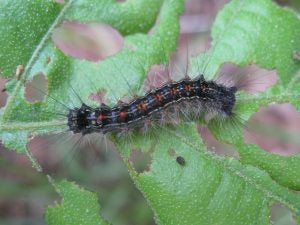
Gypsy moth caterpillar over an inch long is too large to be killed by many insecticides.
Larger caterpillars can be controlled with a spinosad product such as Conserve (commercial applicator), Delegate (commercial fruit production), Entrust (certified Organic production) or Captain Jack’s Deadbug Brew (plant owner). There may be other products available to commercial applicators that effectively control large caterpillars. Do not apply insecticides near plants in flower so as not to kill bees.
Blueberry flowers seem to be particularly susceptible to gypsy moth feeding. Gypsy moth caterpillars chew on flower stems (pedicels) and have killed many blueberry blossoms over a very short period of time. Similar symptoms have been seen in CT and MA. Unfortunately the damage is done and some blueberry crops have been ruined.
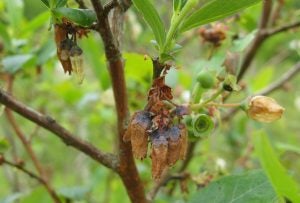
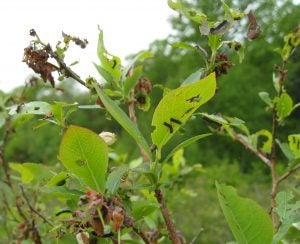
Blueberry blossoms destroyed by gypsy moth caterpillar feeding.
Many communities have been experiencing outbreaks of forest tent caterpillars. I’ve received reports about large populations of forest tent caterpillars from South Kingstown, Richmond, Exeter, Coventry, Saunderstown, Coventry, Rumford, Providence, and several reports from Newport. Forest tent caterpillars have also reported in Voluntown, CT. Forest tent caterpillars hatch about 2 weeks earlier than gypsy moths, and most forest tent caterpillars are very large now. I expect forest tent caterpillars to be full grown and start forming cocoons next week. Last year most forest tent caterpillars had formed cocoons by mid June.
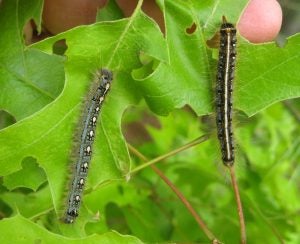
Forest tent caterpillar on left and Eastern tent caterpillar on right. Both are native insects and have been found in large numbers the last couple of years.
Eastern tent caterpillars are nearly finished for the season, but not before defoliating many black cherry trees. Eastern tent caterpillars are dramatic, but don’t cause much damage.
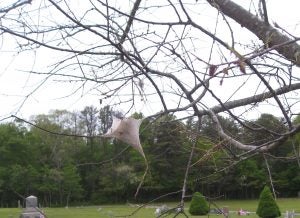
Eastern tent caterpillar nest and damage.
Winter moth caterpillars are finished for the year. We did not find any defoliating populations of winter moths in RI in 2017! Next time winter moths appear will be when male moths are flying to our porch lights in November.
 Home
Home Browse
Browse Close
Close Events
Events Maps
Maps Email
Email Brightspace
Brightspace eCampus
eCampus


